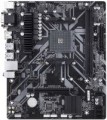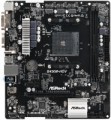Power phases
The number of processor power phases provided on the motherboard.
Very simplistically, phases can be described as electronic blocks of a special design, through which power is supplied to the processor. The task of such blocks is to optimize this power, in particular, to minimize power surges when the load on the processor changes. In general, the more phases, the lower the load on each of them, the more stable the power supply and the more durable the electronics of the board. And the more powerful the CPU and the more cores it has, the more phases it needs; this number increases even more if the processor is planned to be overclocked. For example, for a conventional quad-core chip, only four phases are often enough, and for an overclocked one, at least eight may be needed. It is because of this that powerful processors can have problems when used on inexpensive low-phase motherboards.
Detailed recommendations on choosing the number of phases for specific CPU series and models can be found in special sources (including the documentation for CPU itself). Here we note that with numerous phases on the motherboard (more than 8), some of them can be virtual. To do this, real electronic blocks are supplemented with doublers or even triplers, which, formally, increases the number of phases: for example, 12 claimed phases can represent 6 physical blocks with doublers. However, virtual phases are much inferior to real ones in terms of capabilities — in fact, t...hey are just additions that slightly improve the characteristics of real phases. So, let's say, in our example, it is more correct to speak not about twelve, but only about six (though improved) phases. These nuances must be specified when choosing a motherboard.
Size (HxW)
Motherboard dimensions in height and width. It is assumed that the traditional placement of motherboards is vertical, so in this case one of the dimensions is called not the length, but the height.
Motherboard sizes are largely determined by their form factors (see above), however, the size of a particular motherboard may differ slightly from the standard adopted for this form factor. In addition, it is usually easier to clarify the dimensions according to the characteristics of a particular motherboard than to look for or remember general information on the form factor. Therefore, size data can be given even for models that fully comply with the standard.
The third dimension — thickness — is considered less important for a number of reasons, so it is often omitted.
Max. clock frequency
The maximum RAM clock speed supported by the motherboard. The actual clock frequency of the installed RAM modules should not exceed this indicator — otherwise, malfunctions are possible, and the capabilities of the “RAM” cannot be used to the fullest.
For modern PCs, a RAM frequency of
1500 – 2000 MHz or
less is considered very low,
2000 – 2500 MHz is modest,
2500 – 3000 MHz is average,
3000 – 3500 MHz is above average, and the most advanced boards can support frequencies of
3500 – 4000 MHz and even
more than 4000 MHz.
Max. memory
The maximum amount of RAM that can be installed on the motherboard.
When choosing according to this parameter, it is important to take into account the planned use of the PC and the real needs of the user. So, volumes
up to 32 GB inclusive are quite enough to solve any basic problems and run games comfortably, but without a significant reserve for an upgrade.
64 GB is the optimal option for many professional use cases, and for the most resource-intensive tasks like 3D rendering,
96 GB or even
128 GB of memory will not be a limit. The most “capacious” motherboards are compatible with volumes of
192 GB or
more - they are mainly top-end solutions for servers and HEDT (see “In the direction”).
You can choose this parameter with a reserve – taking into account a potential RAM upgrade, because installing additional RAM sticks is the simplest way to increase system performance. Taking this factor into account, many relatively simple motherboards support very significant amounts of RAM.
XMP
The ability of the motherboard to work with RAM modules that support
XMP (Extreme Memory Profiles) technology. This technology was developed by Intel; it is used in motherboards and RAM blocks and only works if both of these system components are XMP compliant. A similar technology from AMD is called AMP.
The main function of XMP is to facilitate system overclocking (“overclocking”): special overclocking profiles are “sewn” into the memory with this technology, and if desired, the user can only select one of these profiles without resorting to complex configuration procedures. This is not only easier, but also safer: every profile added to the bar is tested for stability.
1x PCI-E slots
Number of PCI-E (PCI-Express) 1x slots installed on the motherboard. There are
motherboards for 1 PCI-E 1x slot,
2 PCI-E 1x slots,
3 PCI-E 1x ports and even more.
The PCI Express bus is used to connect various expansion cards — network and sound cards, video adapters, TV tuners and even SSD drives. The number in the name indicates the number of PCI-E lines (data transfer channels) supported by this slot; the more lines, the higher the throughput. Accordingly, PCI-E 1x is the basic, slowest version of this interface. The data transfer rate for such slots depends on the PCI-E version (see "PCI Express Support"): in particular, it is slightly less than 1 GB / s for version 3.0 and slightly less than 2 GB / s for 4.0.
Separately, we note that the general rule for PCI-E is as follows: the board must be connected to a slot with the same or more lines. Thus, only single-lane boards will be guaranteed to be compatible with PCI-E 1x.
TPM connector
Specialized
TPM connector for connecting the encryption module.
TPM (Trusted Platform Module) allows you to encrypt the data stored on your computer using a unique key that is practically unbreakable (it is extremely difficult to do this). The keys are stored in the module itself and are not accessible from the outside, and data can be protected in such a way that their normal decryption is possible only on the same computer where they were encrypted (and with the same software). Thus, if information is illegally copied, an attacker will not be able to access it, even if the original TPM module with encryption keys is stolen: TPM will recognize the system change and will not allow decryption.
Technically, encryption modules can be built directly into motherboards, but it is still more justified to make them separate devices: it is more convenient for the user to purchase a TPM if necessary, and not overpay for an initially built-in function that may not be needed. Because of this, there are motherboards
without a TPM connector at all.
RGB LED strip
Connector for connecting a decorative LED strip and other devices with LED indication. Allows you to control the backlight of the case through the motherboard and customize the glow for your tasks, including synchronize it with other components.
LAN controller
Model of the LAN controller installed in the motherboard.
The LAN controller provides data exchange between the card and the network port(s) of the computer. Accordingly, both general characteristics and individual features of the network functionality of the "motherboard" depend on the characteristics of this module: support for special technologies, connection quality in case of unstable communication, etc. Knowing the model of the LAN controller, you can find detailed data on it — including including practical reviews; this information is rarely needed by the average user, but it can be useful for online game enthusiasts and for some specific tasks.
Thus, the LAN controller model is specified mainly in cases where it is a rather advanced solution that is noticeably superior to standard models. Such solutions are currently produced mainly under the brands
Intel(middle level),
Realtek(relatively simple models),
Aquntia and
Killer(mostly advanced solutions).

